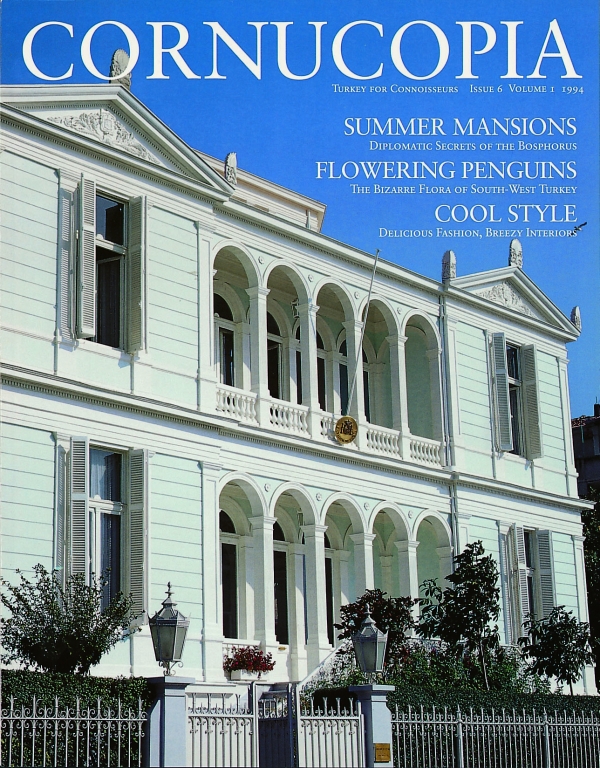Buy or gift a stand-alone digital subscription and get unlimited access to dozens of back issues for just £18.99 / $18.99 a year.
Please register at www.exacteditions.com/digital/cornucopia with your subscriber account number or contact subscriptions@cornucopia.net
Buy a digital subscription Go to the Digital EditionThe Imperial Harem: Women and Sovereignty, by Leslie P Peirce, OUP, New York, 1993
This book is an attempt to reinterpret the period from the 16th to the 17th century that is known in Ottoman history as the ‘sultanate of women’ and characterised by an unprecedented excercise of power by imperial consorts and queen mothers.
One theme of the book is that it is erroneous to think that gender segragation in Islam precluded women from excercising political power. The author ascribes this misconception to the rabid misogyny of the ulema – the body of scholars and clerics trained in religious services which formed and controlled public opinion. The chief dichotomy was now, however, between the sexes but between generations. The junior generations were subject to their elders, who, being past child-bearing age, were not hampered by the restrictions applying to younger women.
The author’s hypothesis is that the pre-eminence and power of the elder female generation was also reflected in the ordinary household. She makes the interesting observation that one of the reasons for the longevity of the Ottoman dynasty (certainly the longest-reigning dynasty with an unbroken succession in the male line in the Middle East and Europe) may have been its readiness to conform to changes in the ordinary family.
The second theme of the book is that although supreme political power was patriarchal (sovereignty being essentially construed as successorhip to the Prophet), the sultan depended on the ruling élite and had to share his power with them. One of the chief means of controlling the élite was through the marriage of high-ranking officials into the imperial family. Female members of the Ottoman dynasty exercised sovereign authority, acting as regents for minor and mentally unstable sultans, though they were debarred from command of the army. Women were also very prominent in the business of dynastic image-making, through charitable religious endowments and monumental building schemes.
Peirce’s main argument is that the growing use of power by imperial women during this period was a logical and indeed intended consequence of the political structure. While it was undoubtedly a logical result of the transition of the state from a warrior (ghazi) state to a more sedentary and centralised bureacratic empire, I do think that it was wholly intended. With Istanbul the imperial capital of the empire, Süleyman the Magnificent’s harem was transferred from the Old Palace in Beyazıt to the Topkapı Palace and all the imperial family came to be lodged under one roof. The Sultan’s person was considered sacred and inevitably some of his glory and prestige was reflected onto his mother– the only person whose hand he kissed.
Until the pattern of succession changed in the early 17th century from vertical (father and son) to horizontal (by seniority), the sultans had their brothers as as their brothers’ sons put to death. With the lapse of the vertical system and the princely governorships, everything came to be enacted at Topkapı Palace. Women now had greater access to the Sultan and to means of influence. With more than one eligible prince present under the same roof, mothers of different princes became involved in the power for succession.
In my opinion, what paved the way to such unprecedented excercise of power by women was the status Süleyman accorded his mother and his consort. His mother, Hafsa, was the first concubine to use the title of sultan and to exercise the prerogative of building an imperial mosque. She was also the first valide sultan, or queen mother, to receive public honours. Süleyman was extremely susceptible to the influence of his wife, Hürrem Sultan (Roxelana). Their marriage shocked the public – he was the first sultan to marry a slave. No other consort ever had the same degree or power over a sultan as Hürremm had over Süleyman. It was at her insistance that the harem was moved to the Topkapı, and her mosque complex was the only one built for any sultan’s concubine or wife during his lifetime…
When the summer heat made cool-headed diplomacy impossible, the ambassadors to the Sublime Porte retired to remarkable residences lining the Bosphorus. Patricia Daunt probes their rich diplomatic history, while Fritz von der Schulenburg captures the faded glory of the buildings and their grounds
The ancient art of ebru, or paper marbling, creates sinuous, swirling patterns of subtle colour which owe their appearance to processes as mysterious as the technique’s very beginnings. Ebru apprentice Ali Suat Urguplu shares his master Fuad Basar’s secrets. Photographs by Simon Upton
They are smelly and poisonous, but arums and aristolochias are among the most striking wild flowers in Turkey. Andrew Byfield tracks them down.
Cherry jam is slightly runny. Rather than adding pectin, it is better to accept that this ruby-coloured jam drips from the toast when you eat it.
More cookery features


Cornucopia works in partnership with the digital publishing platform Exact Editions to offer individual and institutional subscribers unlimited access to a searchable archive of fascinating back issues and every newly published issue. The digital edition of Cornucopia is available cross-platform on web, iOS and Android and offers a comprehensive search function, allowing the title’s cultural content to be delved into at the touch of a button.
Digital Subscription: £18.99 / $18.99 (1 year)
Subscribe now